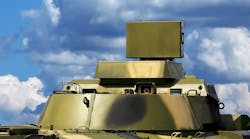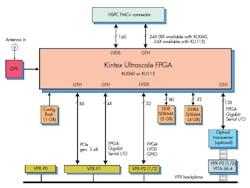3U VPX Board Links Kintex Ultrascale FPGA with VITA 66.4 Backplane
High-speed measurements like radar-antenna data streams require lots of processing. Pentek’s JadeFX Model 5983 (see figure) is a 3U VPX carrier board for FMC and FMC+ modules—FMC+ increases bandwidth by a factor of 2.8.
The Model 5983-320 pairs the carrier board with an FMC module containing a pair of 3-GHz ADCs and two 2.8-GHz DACs. The carrier board has a Xilinx Kintex Ultrascale FPGA that can connect to the VPS P1 connector using a x8 PCI Express Gen 3 connection as well as to the optional VITA 66.4 optical backplane with a dozen high-speed, 12-Gb/s serial connections. There are 32 LVDS connections to the VPX P2 connector.
The Kintex Ultrascale FPGA features 5520 DSP48E2 slices. These can be used for applications such as modulation/demodulation, encoding/decoding, encryption/decryption, and channelization of signals between transmission and reception. The board also comes with a smaller, lower-cost Xilinx KU060 FPGA.
The JadeFX Model 5983 from Pentek is a 3U VPX carrier board for FMC and FMC+ modules. The board incorporates its own Xilinx Kintex Ultrascale FPGA, and supports VITA 66.4 optical backplane connections.
The 5983 has its own GPS receiver. In addition, the carrier board has 9 GB of 1200-MHz DDR4 SDRAM. Air-cooled and ruggedized conduction-cooled versions are available.
The board and Pentek FMCs are supported by the Navigator Design Suite for Streamlined IP Development. The suite includes the Navigator FDK (FPGA design kit) for integrating custom IP and the Navigator BSP (board support package) for creating host software applications. The FDK includes Pentek IP modules; developers can integrate their own IP with these functions. The Navigator kit allows complete replacement of the Pentek IP. The tools have an API interface as well as a graphical user interface for IP design. The Navigator BSP runs on Windows and Linux.
The board can also be immediately used with Pentek’s pre-configured 3U VPX SPARK systems. These come with cabling and software installed. It’s even possible to use a SPARK system for final deployment of many applications.



